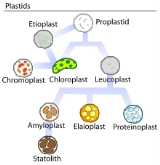
Proteinoplast
Encyclopedia

Organelle
In cell biology, an organelle is a specialized subunit within a cell that has a specific function, and is usually separately enclosed within its own lipid bilayer....
s found only in plant cell
Plant cell
Plant cells are eukaryotic cells that differ in several key respects from the cells of other eukaryotic organisms. Their distinctive features include:...
s. They contain crystalline bodies of protein
Protein
Proteins are biochemical compounds consisting of one or more polypeptides typically folded into a globular or fibrous form, facilitating a biological function. A polypeptide is a single linear polymer chain of amino acids bonded together by peptide bonds between the carboxyl and amino groups of...
and can be the sites of enzyme activity involving those proteins. Proteinoplasts are found in many seeds, such as brazil nut
Brazil Nut
The Brazil nut is a South American tree in the family Lecythidaceae, and also the name of the tree's commercially harvested edible seed.- Order :...
s and peanut
Peanut
The peanut, or groundnut , is a species in the legume or "bean" family , so it is not a nut. The peanut was probably first cultivated in the valleys of Peru. It is an annual herbaceous plant growing tall...
s. Although all plastids contain high concentrations of protein proteinoplasts were identified in the 1960s and 1970s as having large protein inclusions that are visible with both light microscopes and electron microscope
Electron microscope
An electron microscope is a type of microscope that uses a beam of electrons to illuminate the specimen and produce a magnified image. Electron microscopes have a greater resolving power than a light-powered optical microscope, because electrons have wavelengths about 100,000 times shorter than...
s. It is uncertain whether they are in specialist protein storage organelles as amyloplast
Amyloplast
Amyloplasts are non-pigmented organelles found in some plant cells. They are responsible for the synthesis and storage of starch granules, through the polymerization of glucose. Amyloplasts also convert this starch back into sugar when the plant needs energy...
s are starch
Starch
Starch or amylum is a carbohydrate consisting of a large number of glucose units joined together by glycosidic bonds. This polysaccharide is produced by all green plants as an energy store...
storage plastids and elaioplast
Elaioplast
Elaioplasts are a type of leucoplast that is specialized for the storage of lipids in plants. Elaioplasts house oil body deposits as rounded plastoglobuli, which are essentially fat droplets....
s are oil storage plastids. A book written in 2007 noted that no scientific research had been published in the previous 25 years on proteinoplasts.
Proteinoplasts belong to a broad category of organelles known as plastid
Plastid
Plastids are major organelles found in the cells of plants and algae. Plastids are the site of manufacture and storage of important chemical compounds used by the cell...
s. Because they lack pigment, proteinoplasts are more specifically a kind of leucoplast
Leucoplast
Leucoplasts are a category of plastid and as such are organelles found in plant cells. They are non-pigmented, in contrast to other plastids such as the chloroplast....
.
See also
- ChloroplastChloroplastChloroplasts are organelles found in plant cells and other eukaryotic organisms that conduct photosynthesis. Chloroplasts capture light energy to conserve free energy in the form of ATP and reduce NADP to NADPH through a complex set of processes called photosynthesis.Chloroplasts are green...
and etioplastEtioplastEtioplasts are chloroplasts that have not been exposed to light. They are usually found in flowering plants grown in the dark. If a plant is kept out of light for several days, its normal chloroplasts will actually convert into etioplasts. Etioplasts lack active pigment and can technically be... - ChromoplastChromoplastChromoplasts are plastids responsible for pigment synthesis and storage. They, like all other plastids , are organelles found in specific photosynthetic eukaryotic species....
- LeucoplastLeucoplastLeucoplasts are a category of plastid and as such are organelles found in plant cells. They are non-pigmented, in contrast to other plastids such as the chloroplast....
- AmyloplastAmyloplastAmyloplasts are non-pigmented organelles found in some plant cells. They are responsible for the synthesis and storage of starch granules, through the polymerization of glucose. Amyloplasts also convert this starch back into sugar when the plant needs energy...
- ElaioplastElaioplastElaioplasts are a type of leucoplast that is specialized for the storage of lipids in plants. Elaioplasts house oil body deposits as rounded plastoglobuli, which are essentially fat droplets....
- Amyloplast

